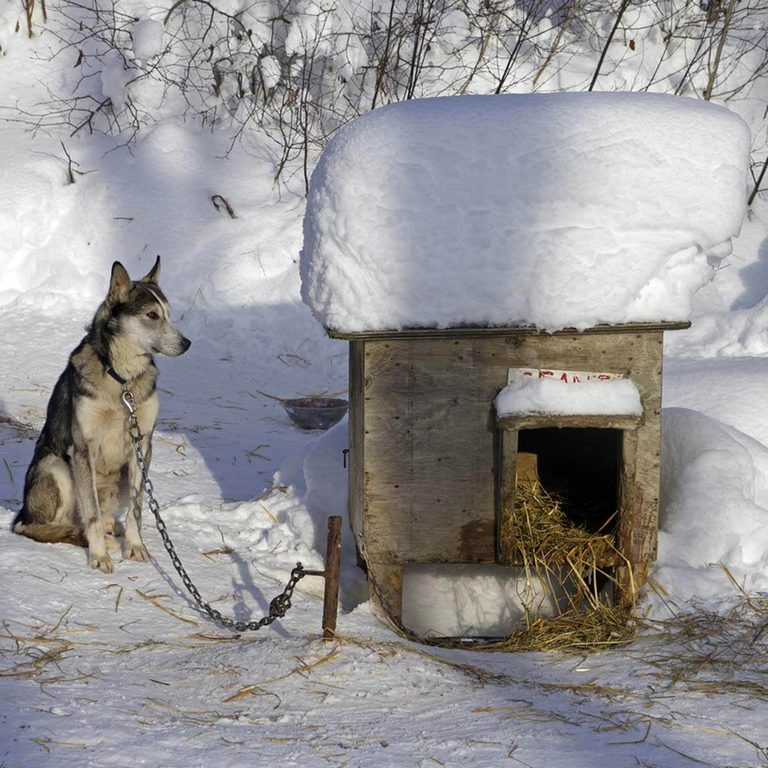Does your dog love the winter or would she rather cuddle up on the couch under a cozy blanket? Either way, you should be prepared to protect her when she ventures out into the elements. Winter care tips for your dog are important to keep her safe this season.
Many dog owners live with the misconception that because their pets have a coat of fur, they can tolerate the cold better than humans. This isn’t necessarily the case. Like us, these fur-coated creatures are used to the warmth of indoor shelter and cold weather can be as hard on them as it is on us humans. Whatever your viewpoint on winter, one thing remains certain: it’s a time when our beloved pets need a little extra care.
MINNIKOVA MARIIA/SHUTTERSTOCK
Understand the Dog
To know the best practices for how to keep a dog house warm in the winter, you need to understand your dog. Some breeds—such as Alaskan Malamutes and Siberian Huskies—can spend more time outside in the winter. While Chihuahuas, Greyhounds and older and very young dogs may not be able to tolerate as much time outside. So know your dog and their tolerance to cold.
BUDIMIR JEVTIC/SHUTTERSTOCK
Dress for the Elements
Smaller dogs and those with less fur may need a little help to keep your dog warm, and a dog sweater or jacket works well. And remember, if you are cold, your dog probably is as well.
BISERKA STOJANOVIC/SHUTTERSTOCK
Keep Paws Clean
During those walks, all that ice, deicer and salt can build up in your dog's paws. And if your dog then licks them, he could be ingesting harmful poisons. Every time you come in from the cold, be sure to wipe down your dog's paws and check for ice buildup. Also, be sure to keep your dog's nails trimmed.
OSADCHAYA OLGA/SHUTTERSTOCKDon't Leave Dogs Outside Alone for Long Periods
When it's extremely cold, dogs shouldn't stay outside for long periods of time. On cold days, limit outside trips to bathroom breaks and exercise, and shorten the walk, if necessary. Also, never leave a pet alone in a car, especially on very cold (or hot) days.
Create Warming Stations Inside
Make sure your dog has a couple of spots in the house to warm up. And a blanket or dog bed works just fine. Beware of space heaters that can easily be knocked over and heated mats that can burn your dog's skin.
Keep Dogs on Leash
When you're out walking your dog in the winter, keep him on a leash. And this will prevent your dog from running off and getting lost in a snowstorm or in the cold woods.
Give Them Shelter
If your dog spends a lot of time outside in the winter months, make sure you provide appropriate shelter. And the shelter should be secured to the ground, have a sloped roof and a soft place to sleep.

GDVCOM/SHUTTERSTOCK
Insulate the Dog House
If you have a dog house, make sure it is insulated. And the floor should be at least 4 inches off the ground and should be insulated with straw to prevent the cold from radiating up from the ground. Place another layer of straw on the floor and consider topping it with some warm bedding. The extra straw will allow the dog to create a nest to keep your dog warm outside and reduce drafts.
Keep Dogs Fed and Hydrated
Make sure all dogs always have access to clean, unfrozen water. And there are heated bowls designed for outdoor dogs. While dogs that live outdoors may be fed more in the winter to help keep their metabolism up, check with your vet before changing your dog's diet.
Bathe Your Dog Inside
If you're giving your dog a bath during the winter, do it inside. And being wet will make a dog cold quickly. Once you're done with the bath, let your dog dry completely before sending him back outside.
GLADSKIKH TATIANA/SHUTTERSTOCKBring All Dogs Inside When It's Extremely Cold
No matter what the breed or age, all dogs should be kept inside when it's extremely cold, even if they have a well-insulated outside kennel. And if it's cold for long periods of time, consider moving an outdoor dog inside until temperatures warm up.
MONTANA ISABELLA/SHUTTERSTOCK
Know Warning Signs
Know the warning signs for both frostbite and hypothermia in dogs. And symptoms can include blisters and skin ulcers, discoloration of skin and pain when you touch body parts. Always be mindful of the outside temperature, keep your dog warm outside and know when to call your veterinarian.
Originally Published by Familyhandyman



















No comments:
Post a Comment